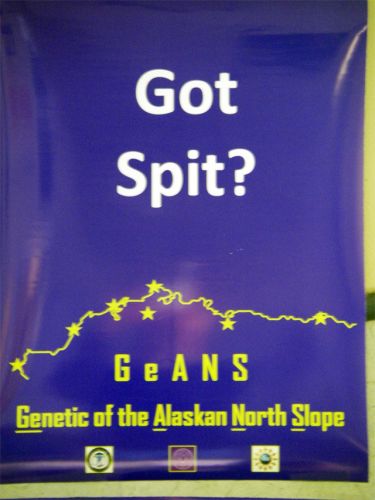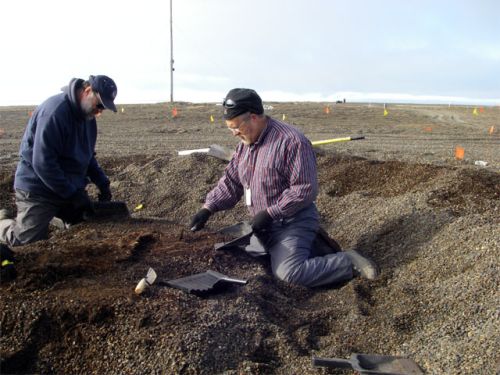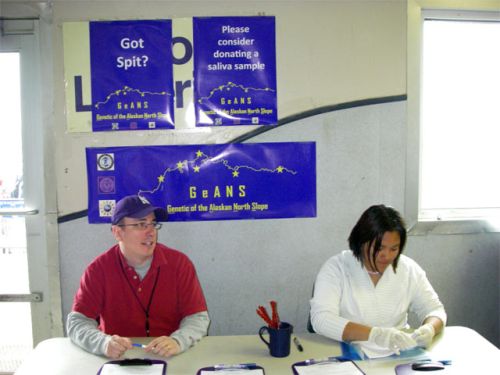Quick Notes
1. If you see a journal that just doesn’t make much sense, send me a quick email or just wait until later in the day. I really try to proof read the journal carefully before posting but every once in awhile I am more than tired and something slips past me. Last night was one of those, falling asleep on the computer evenings. I edited this morning and the journal makes more sense.
2. Don’t forget to sign up for the Live From International Polar YearThe International Polar Year (IPY) is a two year (2007-2009) program of international research and education focused on the Arctic and Antarctic. Click here for more information about IPY. Event (Live From IPY) at www.polartrec.com . This event will include scientists, grad students, and me, all live from the Arctic!! No cost, free entertainment, all you need to a computer and a phone. No internet access, visit a friend’s house or just call in and listen.
3. NEWS FLASH: If you are in the Chester, VT area, head down to CAES for a Live From IPY Party with Julie and Marina Kelley. Dessert is at 6:30PM EDT with the live event at 7:00PM
4. I know my journal and pictures are awesome and wonderful. If you have time, check out some of the other projects going on across the Arctic. Again, they are all available via the www.polartrec.com website.
It’s 11AM on a Saturday, two scientists hop out on an old Ford pickup, grab a box, some gear, and head into the foyer of the local supermarket. Craft vendors extend greetings, a table is set-up, chairs arranged, clipboards readied, and the GeANS SamplingSampling refers to the process of selecting units or portions of a larger group that will be studied in order to answer questions about the larger group. The units can be people, water samples, ice cores, or any other appropriate object. Participants will explore the meaning of sampling and how it impacts experimental design and explore factors that define and limit sampling in the variety of projects visited during the expedition. They will consider how results from the chosen samples are used to describe the bigger target of a project's study. Station is in place!! Two shoppers walk up, put their bags down and learn about the project they are about to participate in. Welcome to the work of Geoff and Dennis!!

This week’s scientists are Dr. Dennis O’ Rourke, from the University of Utah and Dr. Geoff Hayes, from Northwestern University. Dennis and Geoff work on the DNA portion of the NuvukThe Iñupiaq name for Point Barrow and the people who lived there. Archaeology Project. The science of genetics is complicated, fortunately, both Dennis and Geoff have a way of explaining their work in a somewhat simplified, manner.
Basic DNA Overview DNA is the cell material that carries instructions about how our bodies look, how different processes are done in our bodies, and much more. The DNA we have can be found in either the nucleus of the cell or in the mitochondria. An individual’s DNA comes from Mom and Dad. (Ask them how that happens, not me.)
Think of DNA as the instructions or plans for building a very fancy mansion or a shack.
DNA is made up of genes. The genes are specific instructions for specific traits or characteristics. The genes are made up of a code of four different compounds, or building blocks. Adenine, cytosine, guanine, thymine are the four compounds.
The genes would be the instructions for specific parts or activities within your body. Facial features, bone size, or the ability to digest milk effectively.
*The building blocks for all houses are pretty similar; wood, wire, plastic, and glass. The arrangement of these basic materials is what makes a mansion different than a shack. The instructions for the different parts of the house would be similar to the genes. * The DNA for a community or a group of people has some similar characteristics. Think of an ethnic group, maybe Italian or Vietnamese. The two groups are very different, physically as well as biologically. They have different facial features, different hair color, different skin tones, as well as other differences. There are numerous cultural differences as well, but that is not determined by their genes or DNA.
*The same is true for a community of people living in mansions and a community of people living in shacks. You would expect different houses, different foods, different traditions, and different traits. * Last little piece, mitochondria have DNA of their own. All cells have mitochondria. The mitochondria are the power plants of the cell and the DNA from the mitochondria can be sampled and is unique for individuals and has common characteristics for groups.
Hopefully, that gives you a basic idea of what how DNA and genes work for individuals and groups.
Back to the work of Dennis and Geoff. Dennis is able to gather mitochondrial DNA (mt-DNA) from the human remains we uncover. The process involves collecting bone pieces in the field, only a very small piece is needed, about the size of your little finger. The piece is then smashed them into even smaller bits, finally the mt-DNA is extracted using a fairly complicated process. The ancient DNA is then analyzed to determine the code or pattern of the four building blocks. Dennis and his team of graduate students know that there are four basic patterns of DNA for ancient native people here in Alaska as well as in the lower 48. These DNA groups, known as haplo groups, are simply called A, B, C, D. Within each group of native people in the Arctic, from Russia across Alaska, and over to Canada, there are two only two groups, A and D. Some groups have mostly A and a little D, some with mostly D and a little A. Dennis is trying to clearly establish the percents of the different groups here in Barrow.

Geoff is working on collecting modern DNA from native people in the 8 communities that make up the North Slopes Borough. His collection technique is pretty cool, no needles, no swaps, just a test tube that needs about four good spits in it. That’s it.

Geoff then takes his samples back to the lab for analysis, determining again the pattern of the four building blocks. His team of students and researchers can then use the modern DNA to look back at the ancient DNA. Some of the questions they hope to answer over the next few years of collecting and research are: -What groups were in place when and are they still there now? -Are there groups of people that came in and replaced other people? -How are the different communities of Inupiat the same and different? -What are common genetic patterns for all Inupiat? -Where did the genetic patterns come from? -How have the DNA and the Inupiat people changed over time?
While talking with Geoff and Dennis, I was furiously writing notes. Their work is complex and fascinating. I hope my explanation makes sense. Feel free to ask questions, I have until Tuesday to get more answers. On Tuesday, Dennis and Geoff are flying 65 miles inland to one of the villages, Atqasuk. More spit to collect!!
I was struck as I chatted with Dennis and Geoff that these two exceptional educators and researchers are working hard in the field, just like I am, trying to learn more about people and their past. I am very pleased to have had the opportunity to chat with them and listen to their patient explanation. I wish I was able to go into greater detail about the fascinating work they do. Thank you both for your efforts and time, hope the project continues to go well.


Comments